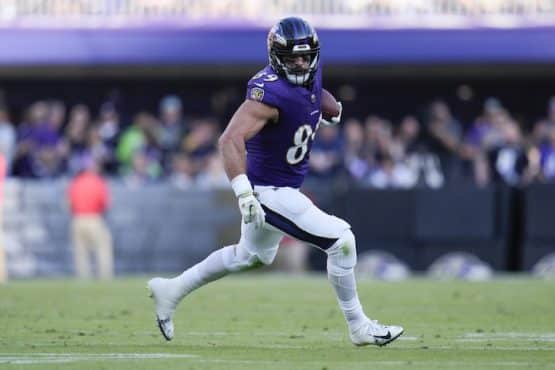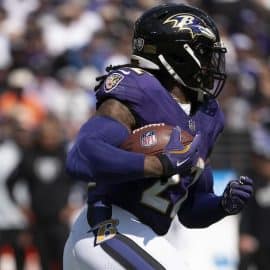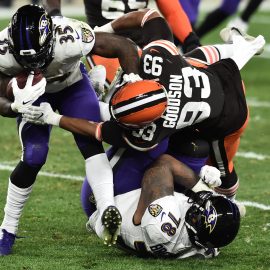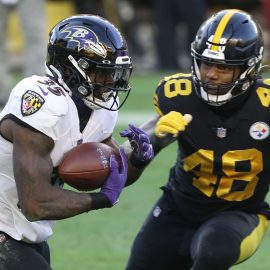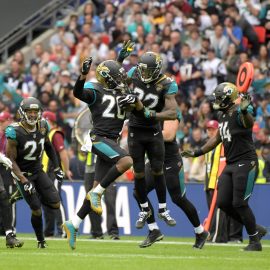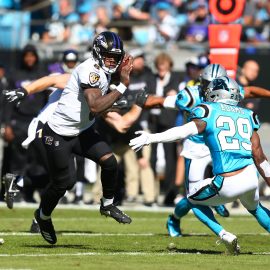Short answer to that question: They can’t! … but their hope is they can seriously limit the impact of the two big tight ends who are both having monster years.
Last time we talked about how sharp and improved the Ravens defensive secondary is right now, and how they’ve become a great coverage unit.
Problem is, you can cover Gronk or Hernandez like a cheap suit, and at their respective heights (6-6, 6-5), they can still beat a defender without achieving horizontal separation. Often they can just go up for a vertical leap and come down with the ball.
A lot of folks have told me you should try to stop Gronk and Hernandez by pressing or chucking them at the line of scrimmage. Two main things wrong with that theory:
1. Brady lines these guys up in the backfield a lot;
2. Brady splits Gronk into the slot or even as a wide-out in the flank a lot;
3. Even if they are lined up at the traditional TE spot on the line, chucking down either one of these huge guys is not an easy task; and by assigning a DE or LB to that task, you’ve just removed a piece of your pass rush on Brady.
In the photo above, Brady has both Gronk and Hernandez lined up in the backfield beside him!
Last week against Denver the Pats spent a bulk of the game in a no-huddle that featured tight ends Rob Gronkowski and Aaron Hernandez (who lined up all over the place) and wideouts Wes Welker, Deion Branch and Julian Edelman. Remarkably, they were able to run effectively out of this personnel grouping, as Hernandez carried the ball five times out of the backfield for 61 yards total rushing of his own.
The real purpose of putting Hernandez in the backfield is the same purpose as all of New England’s other alignments: to get a potent pass catcher matched up on a linebacker. Even safeties have major trouble covering Hernandez and Gronkowski.
Andy Benoit has a nice piece on this subject at CBSSports.com Film Room.
Benoit reminds us of a few hard cold realities for the Ravens: most notably, Baltimore’s starting safeties will not be able to cover Gronkowski…at least not in the traditional sense when we think of the term “coverage”…
“Baltimore’s strong safety Bernard Pollard is simply not capable of doing it, and the Ravens are unlikely to remove Ed Reed from centerfield. Brady rarely throws in the direction of starting cornerbacks. Even when he goes to Wes Welker, it’s often when Welker has drawn a matchup against a backup slot corner or non-cornerback. Because the Patriots don’t try to confuse defenses so much as force them into bad matchups, HOW the Patriots LINE UP to play is almost more important than how they actually play. Most of the damage is done through crafty presnap alignment. (This is one reason so many of Brady’s throws come off three-and five-step drops; the decision of where to go with the ball is made prior to the snap.)”
“The Patriots frequently go up-tempo to prevent defenses from having enough time to regroup or alter matchups before the snap. The only sure way to take the chess match element out of the equations and force the Patriots to win with execution is to play press-man coverage across the board. Problem is, no defense, including Baltimore’s, has enough quality cover artists to do this.”
And like we talked about earlier, you could have a “quality cover” with press-man coverage on Gronk, and he can still beat you with a basketball move.
So pressing Gronk or Hernandez when they’re not lining up in the backfield is not the answer. The Ravens will probably do a zone containment on Brady’s tight ends…and combine that with a pass rush that comes from multiple looks designed to confuse Brady a little and Gronk a lot… and hope that their safeties and linebackers can swarm to the target and hold Gronk and Hernandez to less-than-great gains when the tight ends do catch the ball.
Look for the Ravens to do plenty of presnap communicating and disguising at the line of scrimmage. It helps that they’re comfortable playing a bunch of different coverages. The outcome may be decided by which side can both bully and finesse the other into a reactionary position. The Patriots can do that by going hurry-up; the Ravens can do it by blitzing up the middle….or, more importantly, making it LOOK like a blitz up the middle.
As Benoit astutely observes: “Recent playoff history shows that if a defense can create pressure and doubt, Brady will eventually start eating up the play clock worrying about protections. That makes him a significantly less dangerous player versus when he’s hurrying things up and concentrating on his receivers’ routes.”
The question is, can the Ravens generate a pass-rush? If they blitz, they likely can. But one of the best kept secrets in football is that this is generally a four-man rushing defense. Because the Ravens use so many 3-4 or 2-5 fronts, their four pass-rushers come from a variety of different spots, thus creating the illusion of a blitz.
The Ravens use a lot of zone exchange concepts in their pass-rush. A zone exchange is essentially a four-man pass-rush where linebackers or safeties rush the quarterback, while a defensive lineman or another linebacker drops back into coverage. It can be confusing, often creating the illusion of a heavy blitz.
[Benoit gives you a nice visual look at the Ravens “zone exchange concept” in his article… Worth a look.]
Add The Sports Daily to your Google News Feed!
